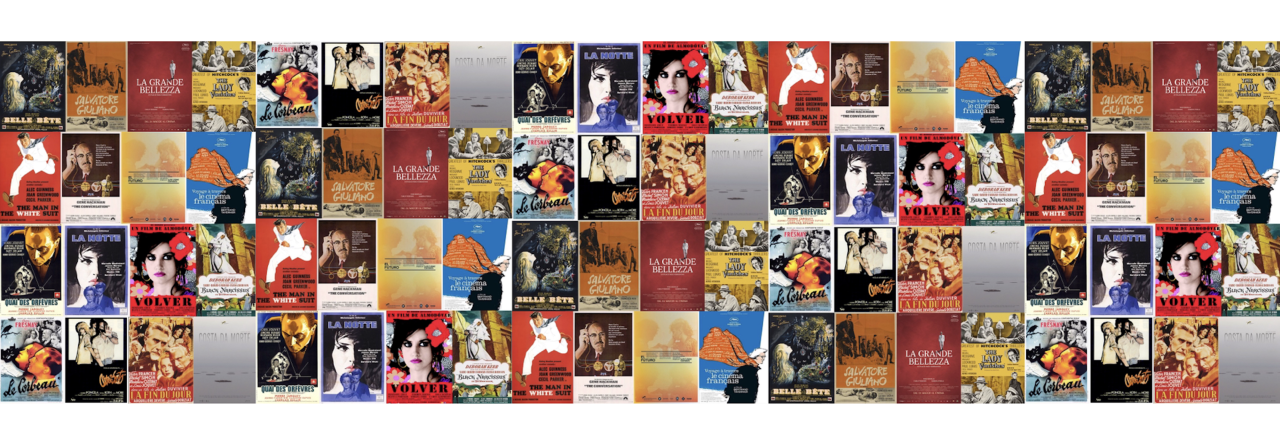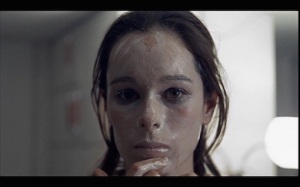
Director: Carlos Saura
Screenplay: Carlos Saura
Cast: Geraldine Chaplin, Rafaela Aparicio, Fernando Fernán Gómez, Amparo Muñoz, Norman Brisky, José Vivó, Charo Soriano, Ángeles Torres, Elisa Nandi.
Synopsis: A matriarch’s 100th birthday is the occasion for scheming skullduggery among her extended family while an old acquaintance offers a potential lifeline.
1973’s Ana y los lobos ended with English nanny Ana (Geraldine Chaplin) being ejected from her employer’s household by Mamá (Rafaela Aparicio) – who blamed the young foreigner for sowing discord among her three adult sons (Fernando Fernán Gómez, José María Prada, José Vivó) – and subsequently attacked by the three men (they forcibly shear off her hair, rape her, and then shoot her in the head). The latter part of Ana’s departure is left ambiguous in terms of whether it is ‘real’ or ‘imagined’ (the brothers are prone to flights of reverie and the film as a whole has a fable-like quality). Mamá cumple 100 años provides the answer insofar as the same characters – including Ana – are reunited years later at the same house for Mamá’s 100th birthday celebrations, although the story is by no means a continuation of the earlier narrative and is a much more comedic take on the dysfunctional household.
The age of the youngest of the three girls Ana previously cared for – Victoria (Elisa Nandi), who seems a lot younger than her siblings, Natalia (Amparo Muñoz) and Carlotta (Ángeles Torres) – suggests that this story is set between 6-8 years later (although the age of the actresses playing the older girls could easily double that). A lot has changed: the girls have grown up; José (played by José María Prada in the previous film – the actor had died between the two productions) died three years ago; Juan (José Vivo) has run off with the cook; Fernando has moved on from levitation to trying to fly with the use of a hand-glider; Juan’s wife Luchy (Charo Soriano) is embezzling Mamá’s money with Carlotta’s help; and Ana is now married, bringing her husband Antonio (Norman Brisky) along for the party. But Mamá is still the same – omniscient (she communicates with Fernando and Ana seemingly by telepathy and can hear all that is going on in the house) and quite the character.
Mamá is aware that her extended family doesn’t view her longevity as a positive, and that in fact several of them (including her remaining sons, but marshalled by her daughter-in-law) are actively plotting her demise; Luchy is convinced that the excitement of the party will cause one of Mamá’s epileptic seizures, and is planning to administer a placebo rather than the elderly woman’s medication (hoping that she will therefore die). The family money has run out and the younger generations have caught on to the value of the land that the house sits on – while Mamá insists that the estate will stay intact while she’s alive, the others are already lining up a sale to land developers. Mamá has invited Ana to the party because as an outsider she can be trusted – she is given a vial of medication and asked to intervene if Mamá has another attack (we have already witnessed one on the day Ana arrives).
The film is anomalous within the rest of Saura’s filmography from this period. Aside from two stylised and theatrical tableaux vivant – one in the middle of a dinner when Fernando uses the remnants of his earlier mysticism to summon his wayward brother home at their mother’s request, the other in the aftermath of Mamá’s expected seizure during the party, all those present frozen in place – the film reminded me less of Saura, and more of Luis García Berlanga’s La escopeta nacional (1978). Dark humour is threaded through many of Saura’s early films, but Mamá cumple 100 años unexpectedly fits within a contemporaneous trend for bawdy post-censorship Spanish comedy (although – as with Berlanga – the bawdiness doesn’t detract from the critique or satire of Spanish society also at play) and, perhaps unsurprisingly, it was one of the bigger films at the Spanish box office in the year of its release. It is enjoyably farcical but also laced with bitterness (few of the family members demonstrate any fidelity to each other), and Saura can still be seen as engaging in social critique as per the Spanish tradition of esperpento (a dark humour in which a distorted version of reality is utilised in order to critique it).
This was the last film that Saura and Chaplin made together. It seems appropriate that their collaboration looped back on itself to revisit an earlier character, much in the same way that Saura’s films individually play with time and memory; the revisiting allows a contrast between then and now, and captures the passing of time through Chaplin’s face. Ana is perhaps more straightforward than many of the other characters Chaplin inhabits in the Saura/Chaplin films – for one thing, she is the only character Chaplin plays in this film. Ana is the only character given the privilege of a flashback (remembering José, via a sequence from Ana y los lobos) but she also represents a warning that nostalgia for the past can blind us to current realities. By reputation Chaplin doesn’t discuss Saura, but on the BFI edition of Cría cuervos there is a documentary profile of the director (Portrait of Carlos Saura (José Luis López-Linares, 2004)) in which she is interviewed. After talking about how they came to work together (the publicist working on Dr Zhivago introduced them), she says “I have nothing bad to say about Carlos. [Pause] Now, if you’d asked me years ago!” and with a grin bursts out laughing. In interviews (old and more recent) Saura repeatedly credits Chaplin with expanding his world view (and his view of women), but very little critical attention seems to have been given to her performances / contributions in these films. I’ve said before that I’d like to write an in-depth piece about her roles and performances in the Saura/Chaplin films, and it is still my intention to do that at some point in the future.
This is the last post for the ‘Carlos Saura Challenge: 1962-1979’. I’m hoping that I will manage to wrangle the next collection (1980-1999) together by early 2018 (I think that aiming for the end of this year would be a bit too optimistic given how many films it involves and how irregular my viewing habits currently are), with 2000-2017 following on that summer.













